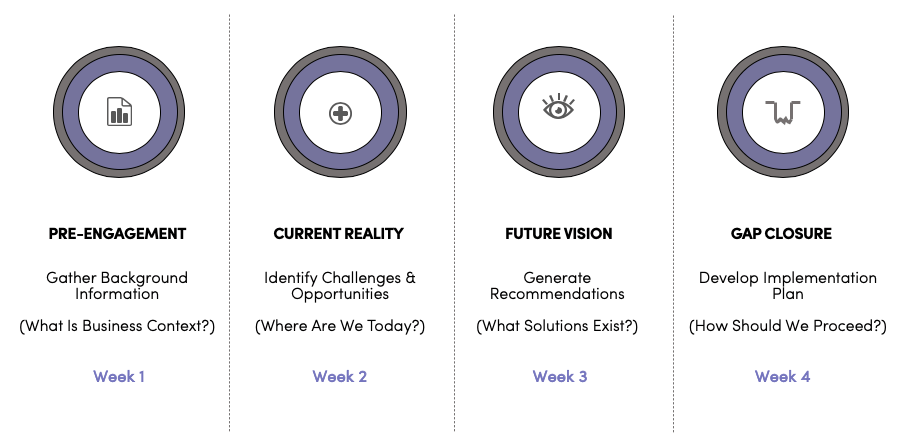Process Mapping
Process mapping has moved from war rooms with white boards and multi-colored Post-It notes to software that visually presents process steps and tasks. Standards, such as Business Process Management Notation (BPMN), can serve as powerful tools for providing a common language to manually document processes across the organization. They enable subject matter experts and key stakeholders to collaborate on process changes and improvement opportunities. The challenge is that the output of process mapping is based upon an understanding of how a particular process works in their company. They also document process steps at a point-in-time. As a result, process mapping can be used to identify target processes that would benefit from a more detailed and comprehensive analysis using process mining and discovery software.
Process Mining and Discovery
Process mining captures the actual business process by extracting transactional data from existing software applications (e.g., event logs) and, using specialized algorithms, builds a detailed visual description of a business process. It is often used to discover process bottlenecks (e.g., due to resource constraints, poor training), audit current process compliance (e.g., “maverick” purchases with unapproved vendors), identify process improvement opportunities (often through simulation) and quantify the business value of process changes through redesign and/or automation (e.g., robotic process automation or RPA). Because process mining can be done at relatively low cost, companies interested in process improvements, either to reduce costs or to improve agility, can use this technology to quickly assess the impact of process changes relative to desired outcomes.
Application:
Process mapping, mining and discovery tools can be used effectively to define operational processes across the business, both horizontal (common to many businesses) and vertical (unique to particular industries). Some example of these would include:
- Finance (record-to-report) – improve productivity, reduce working capital, manage risk
- Procurement (procure-to-pay) – improve productivity, optimize spend, reduce maverick spend
- Logistics and Distribution (order-to-delivery) – improve productivity, optimize inventory levels
- Human Resources (hire-to-retire) – improve productivity, manage benefits admin, optimize new hire onboarding
- Sales (prospect-to-order) – improve productivity, improve time to quote, reduce ordering errors
- Customer Service (problem-to-resolution) – improve first response resolution, reduce handle time
- Banking (application-to-close) – improve accuracy and quality, increase conversion rates, reduce loan application cycle times
- Insurance and Healthcare Revenue Cycle Management (claim-to-adjudication) – reduce errors and effort, improve claims processing times
Process mining and discovery tools are well-suited in environments where:
- Digital transformation requires a bottoms-up approach (i.e., focused on business processes)
- Substantial business benefits can be realized by redesigning and possibly automating processes
- Adequate operational data is available from transactional systems that can be mined
- Target processes include at least two business domains (e.g., Sales, Customer Service)
- Target processes are not well-known or documented
Often, processing mining and discovery software vendors utilize pre-configured process analysis templates that can be used to address common process issues. Many also have connectors or APIs to capture data from event logs of popular software applications (e.g., SAP, Oracle, Salesforce.com, ServiceNow, etc.). Finally, process mining tools can be used to support robotic process automation platforms by identifying areas where automation can deliver business value.
How To Get Started:
In the lifecycle of business process optimization, the path forward often starts with identifying current enterprise processes that should be targeted for analysis, improvement and/or redesign. This approach is often intuitive, but most business leaders have a feel for processes that are underperforming. In any case, executive sponsors and key stakeholders should encourage a robust discussion and solicit a variety of viewpoints to identify the most appropriate business processes to be redesigned.
A complementary approach would segregate processes into two camps – those that can benefit the enterprise by being more agile (typically customer-facing) and those that can deliver significant cost savings through optimization. Process mining and discovery tools, with their analytical and modeling capabilities, can provide the insights needed to determine which processes should be agile and which should be optimized. These same tools also have the ability to quantify the business impact and related benefits through process improvements.
Once the targeted business processes are identified, the following four steps should be implemented (courtesy of Celonis):
- Collect process data – identify source systems, extract data from system event logs, convert data to format used by mining tool
- Discover process opportunities – visualize process steps (the mining tool does this), identify points of friction and root causes, discover optimal process flows (“happy path” and variants)
- Enhance business processes – remove unneeded process steps, add missing process steps, automate appropriate process steps, simulate these changes to determine business impact
- Monitor process performance – checkpoint process performance and compliance on a periodic basis by repeating the first three steps
Major Process Mining & Discovery Vendors
- ProcessGold (UiPath)
- Signavio
- Celonis
- myinvenio
Get Started with Our SnapShot Assessment
Our SnapShot Assessment is a quick and easy way to refine your project strategy and scope, and build the business case for achieving your broader business objectives. The typical SnapShot follows a four-step process over an average of 4 weeks:


